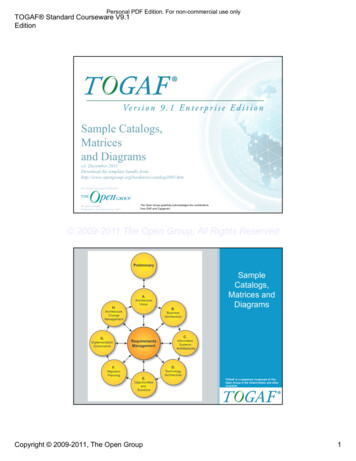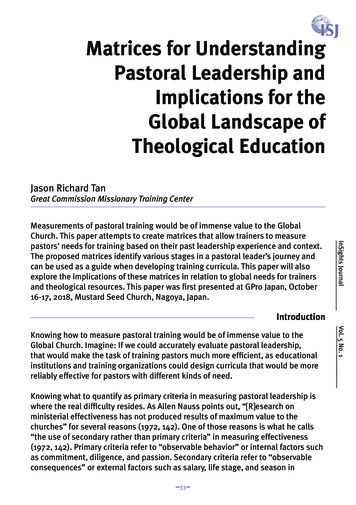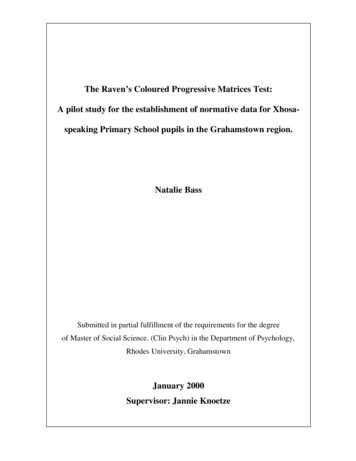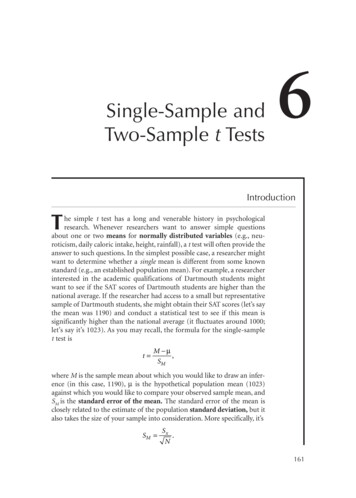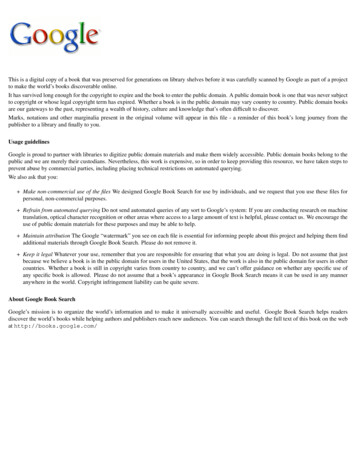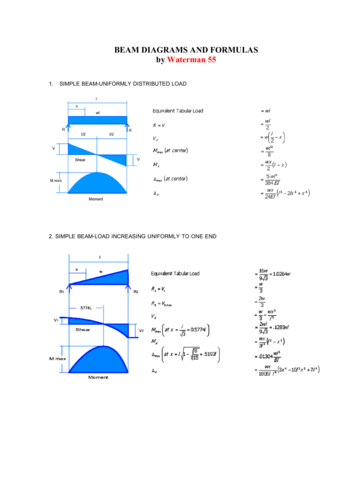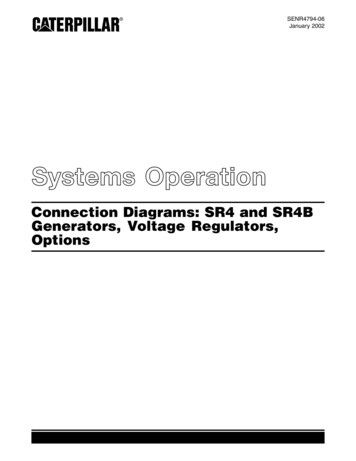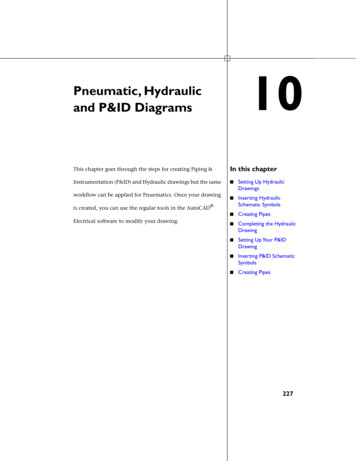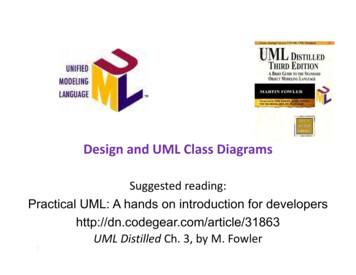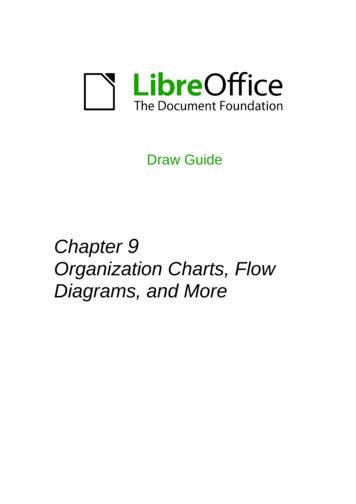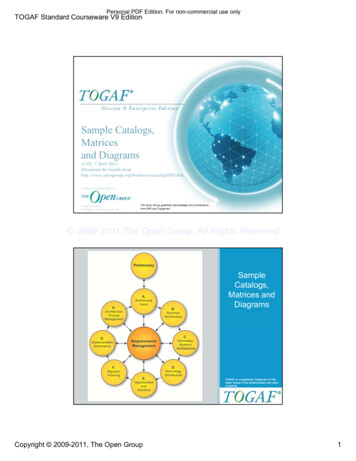
Transcription
Personal PDF Edition. For non-commercial use onlyTOGAF Standard Courseware V9 EditionSample Catalogs,Matricesand Diagramsv2.02: 7 April 2011Download the bundle 3.htmV9 Edition Copyright 2009-2011Slide 1 2009-2011 The Open Group,All Rights ReservedThe Open Group gratefully acknowledges the contributionsAll rights reservedPublished by The Open Group, 2011from SAP and Capgemini 2009-2011 The Open Group, All Rights ReservedSampleCatalogs,Matrices andDiagramsTOGAF is a registered trademark of TheOpen Group in the United States and othercountriesSlide 2 2009-2011 The Open Group, All Rights ReservedCopyright 2009-2011, The Open Group1
Personal PDF Edition. For non-commercial use onlyTOGAF Standard Courseware V9 EditionObjectivesThe objectives of this presentation are to illustrate: TOGAF 9 Catalogs, Matrices and Diagrams What they consist of Examples How they can be usedThe examples shown are illustrative.The exact format of the catalogs,matrices and diagrams will dependon the tools used and adaptations toTOGAF for the specific EA.Slide 3 2009-2011 The Open Group, All Rights Reserved 2009-2011 The Open Group, All Rights ReservedTOGAF 9Catalogs, Matrices and DiagramsPreliminary Phase PrinciplescatalogPhase A, ArchitectureVision Stakeholder MapmatrixValue ChaindiagramSolution ConceptdiagramPhase B, Business Architecture Organization/Actor catalog Driver/Goal/Objective catalog Role catalog Business Service/Function catalog Location catalog Process/Event/Control/Productcatalog Contract/Measure catalog Business Interaction matrix Actor/Role matrix Business Footprint diagram Business Service/Information diagram Functional Decomposition diagram Product Lifecycle diagram Goal/Objective/Service diagram Business Use-Case diagram Organization Decomposition diagram Process Flow diagram Event diagramPhase D, Technology Architecture Technology Standards catalog Technology Portfolio catalog System/Technology matrix Environments and Locations diagram Platform Decomposition diagram Processing diagram Networked Computing/Hardware diagram Communications Engineering diagramPhase C, Data Architecture Data Entity/DataComponent catalogData Entity/BusinessFunction matrixSystem/Data matrixClass diagramData DisseminationdiagramData Security diagramClass HierarchydiagramData Migration diagramData Lifecycle diagramPhase C, Application Architecture Phase E. Opportunities &Solutions Project Contextdiagram Benefits diagramApplication Portfolio catalogInterface catalogSystem/Organization matrixRole/System matrixSystem/Function matrixApplication Interaction matrixApplication CommunicationdiagramApplication and User LocationdiagramSystem Use-Case diagramEnterprise ManageabilitydiagramProcess/System RealizationdiagramSoftware Engineering diagramApplication Migration diagramSoftware Distribution diagramRequirements Management Requirements catalogSlide 4 2009-2011 The Open Group, All Rights ReservedCopyright 2009-2011, The Open Group2
Personal PDF Edition. For non-commercial use onlyTOGAF Standard Courseware V9 EditionPPreliminary PhaseCatalogs, Matrices and DiagramsCatalogs Principles CatalogDiagramsMatricesSlide 5 2009-2011 The Open Group, All Rights Reserved 2009-2011 The Open Group, All Rights e Principles catalog captures principles of the business and architectureprinciples that describe what a "good" solution or architecture should looklike. Principles are used to evaluate and agree an outcome for architecturedecision points. Principles are also used as a tool to assist in architecturalgovernance of change initiatives.The Principles catalog contains the following metamodel entities:* PrincipleSlide 6 2009-2011 The Open Group, All Rights ReservedCopyright 2009-2011, The Open Group3
Personal PDF Edition. For non-commercial use onlyTOGAF Standard Courseware V9 EditionAArchitecture VisionCatalogs, Matrices and DiagramsCatalogsMatrices Stakeholder Map MatrixDiagrams Value Chain Diagram Solution Concept DiagramSlide 7 2009-2011 The Open Group, All Rights Reserved 2009-2011 The Open Group, All Rights ReservedAStakeholderExample Stakeholder MapMatrixInvolvementClassRelevant ArtifactsCxOThis stakeholder group is interested in thehigh-level drivers, goals and objectives ofthe organization, and how these aretranslated into an effective process and ITarchitecture to advance the businessKeepSatisfiedBusiness FootprintGoal/Objective/ServiceModelOrganization ChartProgramManagementOfficeThis stakeholder group is interested inprioritizing, funding, and aligning changeactivity. An understanding of project contentand technical dependencies adds a furtherdimension of richness to portfoliomanagement and decision making.KeepSatisfiedRoadmapsBusiness sitionHRKey features of the enterprise architectureare roles and Actors that support thefunctions, applications, and technology ofthe organization. HR are importantstakeholders in ensuring that the correctroles and actors are represented.KeepInformedOrganization ChartOrganization/Actor/LocationSlide 8 2009-2011 The Open Group, All Rights ReservedCopyright 2009-2011, The Open Group4
Personal PDF Edition. For non-commercial use onlyTOGAF Standard Courseware V9 EditionAExample Value Chain DiagramSource: Wikipedia.orgSlide 9 2009-2011 The Open Group, All Rights Reserved 2009-2011 The Open Group, All Rights ReservedAValue Chain DiagramProduct& OfferSalesFulfilmentPaymentsServicingSlide 10 2009-2011 The Open Group, All Rights ReservedCopyright 2009-2011, The Open Group5
Personal PDF Edition. For non-commercial use onlyTOGAF Standard Courseware V9 EditionAValue Chain DiagramSlide 11 2009-2011 The Open Group, All Rights Reserved 2009-2011 The Open Group, All Rights ReservedA Example Solution Concept Diagram A high-level representation of the solution envisaged A pencil sketch of the expected solution at the outset of rsInterest,consideration,join, re-newCertificationPublicationReliable, 24x7,self-serviceinfrastructureSlide 12 2009-2011 The Open Group, All Rights ReservedCopyright 2009-2011, The Open Group6
Personal PDF Edition. For non-commercial use onlyTOGAF Standard Courseware V9 EditionASolution Concept DiagramSlide 13 2009-2011 The Open Group, All Rights Reserved 2009-2011 The Open Group, All Rights ReservedASolution Concept DiagramToday’s use of channelsTomorrow’s use of channelsHigh Value TasksRMRMSERVICETEAMFrom RMto STSERVICE TEAMFrom ServiceTeam to CCFrom RMto CCCALL CENTERCALL CENTERSELF SERVICEINTERNET PORTALFrom CallCentre toOnlineFrom ServiceTeam toOnlineFrom RMto OnlineSELF SERVICE INTERNET PORTALLow Value TasksSlide 14 2009-2011 The Open Group, All Rights ReservedCopyright 2009-2011, The Open Group7
Personal PDF Edition. For non-commercial use onlyTOGAF Standard Courseware V9 EditionBBusiness ArchitectureCatalogs, Matrices and DiagramsCatalogs Organization/Actor catalog Driver/Goal/Objective catalog Role catalog Business Service/Functioncatalog Location catalog Process/Event/Control/Productcatalog Contract/Measure catalogMatrices Business Interaction matrix Actor/Role matrixDiagrams Business Footprint diagram Business Service/Informationdiagram Functional Decompositiondiagram Product Lifecycle diagram Goal/Objective/Service diagram Business Use-Case diagram Organization Decompositiondiagram Process Flow diagram Event diagramSlide 15 2009-2011 The Open Group, All Rights Reserved 2009-2011 The Open Group, All Rights urposeA definitive listing of all participants that interact with IT, including users and ownersof IT systems.It contains the following metamodel entities: Organization Unit, Actor Location (may be included in this catalog if an independentLocation catalog is not maintained)Driver/Goal/ObjectiveCatalogA cross-organizational reference of how an organization meets its drivers in practicalterms through goals, objectives, and (optionally) measures.It contains the following metamodel entities: Organization Unit, Driver, Goal, Objective, Measure (may optionally be included)Role CatalogThe purpose of the Role catalog is to provide a listing of all authorization levels orzones within an enterprise. Frequently, application security or behavior is definedagainst locally understood concepts of authorization that create complex andunexpected consequences when combined on the user desktop.It contains the following metamodel entities: RoleSlide 16 2009-2011 The Open Group, All Rights ReservedCopyright 2009-2011, The Open Group8
Personal PDF Edition. For non-commercial use onlyTOGAF Standard Courseware V9 EditionBCatalogsCatalogPurposeBusinessService /FunctionCatalogA functional decomposition in a form that can be filtered, reported on, and queried, asa supplement to graphical Functional Decomposition diagrams.It contains the following metamodel entities:LocationCatalogA listing of all locations where an enterprise carries out business operations orhouses architecturally relevant assets, such as data centers or end-user computingequipment.It contains the following metamodel entities: LocationProcess/Event/Control/ProductCatalogThe Process/Event/Control/Product catalog provides a hierarchy of processes, eventsthat trigger processes, outputs from processes, and controls applied to the executionof processes. This catalog provides a supplement to any Process Flow diagrams thatare created and allows an enterprise to filter, report, and query across organizationsand processes to identify scope, commonality, or impact.It contains the following metamodel entities: Organization Unit,Business Function, Business Service, Information System Service(may optionally be included here) Process, Event, Control, ProductSlide 17 2009-2011 The Open Group, All Rights Reserved 2009-2011 The Open Group, All Rights poseA listing of all agreed service contracts and (optionally) the measuresattached to those contracts. It forms the master list of service levelsagreed to across the enterprise.It contains the following metamodel entities: Business Service Information System Service (optionally) Contract MeasureSlide 18 2009-2011 The Open Group, All Rights ReservedCopyright 2009-2011, The Open Group9
Personal PDF Edition. For non-commercial use onlyTOGAF Standard Courseware V9 EditionBMatrices Business Interaction matrix Actor/Role matrixSlide 19 2009-2011 The Open Group, All Rights Reserved 2009-2011 The Open Group, All Rights ReservedBBusiness Interaction Matrix The purpose of this matrix is to depict the relationshipinteractions between organizations and business functionsacross the enterprise.Providing Business ServicesConsuming Business ServicesEngineering Procurement Manufacturing Sales and Distribution Customer ServiceEngineeringProcurementContract forsupply ofmaterialsManufacturingSales and DistributionContract forsupply ofproductspecificationCustomer ServiceContract for supply ofsales forecastsContract forsupply of productContract for fulfillment ofcustomer ordersSlide 20 2009-2011 The Open Group, All Rights ReservedCopyright 2009-2011, The Open Group10
Personal PDF Edition. For non-commercial use onlyTOGAF Standard Courseware V9 EditionBActor/role Matrix The purpose of this matrix is to show which actors performwhich roles, supporting definition of security and CRRCCCCIAExternal Vendors / SuppliersHead of ImplementationIIIIIAAAACIICCCCCCProject ManagerEnterprise Infrastructure ArchitectIIIIIRCIIIIT OperationsInfrastructure Solution ArchitectICIRCCCIICInfrastructure DesignerInfrastructure StrategistIIRRRRRCRIACIArchitecture Configuration ManagerHead of Strategy and ArchitectureIIBusiness Unit Service OwnerIIRIIBusiness Unit HeadCRIIIIT Management CIAAIRCICCStrategy and ArchitectureActorsBusiness Unit Application ArchitectBusiness UnitActorsTechnical Design AuthorityISteering GroupActorsEnterprise Design AuthorityIIIEnterprise ArchitectR Responsible for carrying out the roleA Accountable for actors carrying out the roleC Consulted in carrying out the roleI Informed in carrying out the roleStrategy Lifecycle RolesArchitecture RefreshArchitecture RoadmapBenefits AssessmentChange ManagementFramework RefreshProject Lifecycle RolesSolution Architecture VisionLogical Solution ArchitecturePhysical Solution ArchitectureDesign GovernanceArchitecture Configuration ManagementCIOOffice ofCIO ActorsCCIRRRCASlide 21 2009-2011 The Open Group, All Rights Reserved 2009-2011 The Open Group, All Rights ReservedB DiagramsBusiness Footprint diagramBusiness Service/Information diagramFunctional Decomposition diagramProduct Lifecycle diagramGoal/Objective/Service diagramBusiness Use-Case diagramOrganization Decomposition diagramProcess Flow diagramEvent diagramSlide 22 2009-2011 The Open Group, All Rights ReservedCopyright 2009-2011, The Open Group11
Personal PDF Edition. For non-commercial use onlyTOGAF Standard Courseware V9 EditionBBusiness Footprint Diagram Describes the links between business goals, organizationalunits, business functions, and services, and maps thesefunctions to the technical components delivering therequired capability. Demonstrates only the key facts linking organization unitfunctions to delivery services and is utilized as acommunication platform for senior-level (CxO) stakeholdersSlide 23 2009-2011 The Open Group, All Rights Reserved 2009-2011 The Open Group, All Rights ReservedB Example Business Footprint DiagramSlide 24 2009-2011 The Open Group, All Rights ReservedCopyright 2009-2011, The Open Group12
Personal PDF Edition. For non-commercial use onlyTOGAF Standard Courseware V9 uteGoods / ServicesC4Support ServicesStore OperationsC5 ManageInvoiceCustomerCashBusiness ProcessIntegration LayerC0 Orderto-CashBusiness Footprint DiagramAccountsReceivableSupply Chain MgmtFunctionalServices LayerUser e 25 2009-2011 The Open Group, All Rights Reserved 2009-2011 The Open Group, All Rights ReservedBBusiness Footprint DiagramSC2 –Plan sales &operationsSC1 – Plan &manage the demandSC11 - MonthlyForecast GenerationSC3 –Establish inventoryplanSC4 –DefinemanufacturingplanSC51 – Logistics CapacityPlanningSC22 – Cross-UOT Demand & Supply Balancingand LP S&OP validationSC12 - MonthlyForecast CollaborationSC21 – UOT and LPS Tactical Supply PlanningSC17 – ForecastWeekly UpdateSC32 – InventoryManagement RulesParameter DefinitionSC16 – Demandexplosion for assemblySC42 – Multi-PlantPlanningSC52 – DistributionSupply Planning – midTermSC53 – DistributionSupply Planning – shortTermSC54 - Distributionshortage managementSC41 – PlantProduction PlanningSC13 – Planneddemand consumptionby customer orderSC5 - Plan goodsmovements andresources in thedistribution networkSC61 – WarehouseManagementSC62 – Long DistanceTransportationSC63– Short-DistanceTransportationGFB57- Process stepstraceabilitySC55 – DeploymentSC56 – Intra-groupexchanges managementSC14 – AllocationDefinition Rules forATP (monthly)SC15 – AllocationDefinition Rules forATP (daily)SC6 –Schedule & executegoods movements,storage andtransportationdecisionsSC57 – Procurementexchanges managementSC65 – TransportationadministrationGFB58 – ProductTraceabilitySC70 - Inventory Management (physical and planned inventory including internal transfer orders)SC04 - InventoryNorms DefinitionSC0 - ReferentialGFB64 - Supply Chain Costs & Margin ReferentialGFB61 – Supply Chain Referential – LogisticsResourceGFB62 – Supply Chain Referential – Production Process ModelGFB63 – DemandPlanning ReferentialGFB65 - Supply Chain Referential – Production & Distribution & Ship to Customer NetworkGFB59 – Product & Services – Client CatalogGFB50 – Product & Services ReferentialGFB51 - Client ReferentialSC9- BISC91 – Demand BI /ReportingSC92 – Tactical PlanningBI / ReportingSC93 – Inventory BI /ReportingSC94 – Plant Planning BI/ ReportingSC95 – DistributionPlanning BI / ReportingSC96 – Logistics BI /ReportingGFB70 – Global Cross-Domain Reporting & AnalysisSlide 26 2009-2011 The Open Group, All Rights ReservedCopyright 2009-2011, The Open Group13
Personal PDF Edition. For non-commercial use onlyTOGAF Standard Courseware V9 EditionBBusiness Footprint DiagramSlide 27 2009-2011 The Open Group, All Rights Reserved 2009-2011 The Open Group, All Rights ReservedBBusiness Service/Information Diagram Shows the information needed to support one or morebusiness services. Shows what data is consumed by or produced by abusiness service and may also show the source ofinformation. Shows an initial representation of the information presentwithin the architecture and therefore forms a basis forelaboration and refinement within Phase C (DataArchitecture).Slide 28 2009-2011 The Open Group, All Rights ReservedCopyright 2009-2011, The Open Group14
Personal PDF Edition. For non-commercial use onlyTOGAF Standard Courseware V9 EditionBExample Business Service/InformationDiagramBasic exampleSlide 29 2009-2011 The Open Group, All Rights Reserved 2009-2011 The Open Group, All Rights ReservedBExample Business Service/InformationDiagramExtended example showing actorsand service interactionsSlide 30 2009-2011 The Open Group, All Rights ReservedCopyright 2009-2011, The Open Group15
Personal PDF Edition. For non-commercial use onlyTOGAF Standard Courseware V9 EditionBusiness Services andInformation DiagramSlide 31 2009-2011 The Open Group, All Rights Reserved 2009-2011 The Open Group, All Rights ReservedBusiness Services andInformation DiagramSlide 32 2009-2011 The Open Group, All Rights ReservedCopyright 2009-2011, The Open Group16
Personal PDF Edition. For non-commercial use onlyTOGAF Standard Courseware V9 EditionBFunctional Decomposition Diagram It shows on a single page the capabilities of an organizationthat are relevant to the consideration of an architecture. By examining the capabilities of an organization from afunctional perspective, it is possible to quickly developmodels of what the organization does without beingdragged into extended debate on how the organizationdoes it.Slide 33 2009-2011 The Open Group, All Rights Reserved 2009-2011 The Open Group, All Rights ReservedB Example Functional DecompositionDiagramSlide 34 2009-2011 The Open Group, All Rights ReservedCopyright 2009-2011, The Open Group17
Personal PDF Edition. For non-commercial use onlyTOGAF Standard Courseware V9 EditionBFunctional Decomposition inessPlanningMarketing&SalesManage PublicDevelop & TrackPlan HumanFormulateDevelop NewRelationsFinancial PlanResourcesStrategyBusinessProvide Develop andMaintainBusiness PlanEstablishCustomerRequirementsPerformAudit& ControlsDevelop &ManageProduct esManage AssetsDevelopObtain ovideCustomerSupportManage UnionActivitiesTerminate ActiveEmploymentEngineeringResearch andDevelopTechnologyInventoryPlan MaterialRequirementsEngineer andDesign ProductsProcureEquipmentMaterial & ToolsEngineer ManufacturingRequirementsEngineerPackagesPerform QualityShipEngineeringProductsConvertResourcesto ProductDesign ToolsManageControland esDistributionMaintain PlantEquipment &ToolsManageWarrantyActivitiesSlide 35 2009-2011 The Open Group, All Rights Reserv
Key features of the enterprise architecture are roles and Actors that support the functions, applications, and technology of the organization. HR are important stakeholders in ensuring that the correct roles and actors are repres
